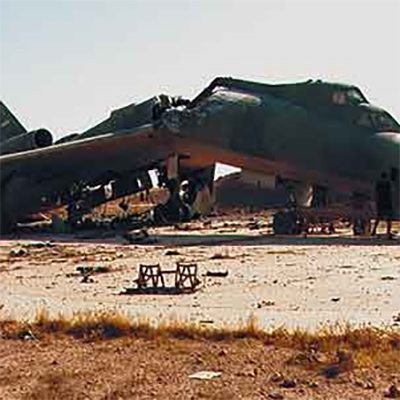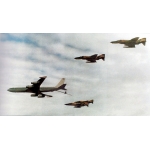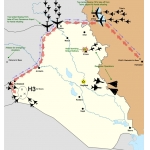Operation H-3
Mohsen Shirmohammad
350 بازدید
The three airfields located in the westernmost point of Iraq, on the Jordanian border, are called H-3.
The complex consists of three bases: Al-Walid as the main base, Al-Murasana to the northwest, and Al-Taba’at to the southwest of the main base [1]. This forms a triangle 100 kilometers from the Jordanian border. In 1935, a runway for landing aircrafts was built at the H-3 pump house on the route of the oil pipeline from Mosul to the port of Haifa (Israel). In the 1970s, it was expanded to counter possible Israeli attacks and became a base of the Iraqi Air Force [2].
After the Iraqi army attacked Iran on September 21, 1970 and the start of the Imposed War, the Iranian Air Force’s attacks on Iraqi air bases forced the enemy to move some of its aircraft to western Iraq. In mid-October 1970, documents were provided to the Air Force confirming the transfer of Iraqi aircraft to western Iraq [3]. Ilyushin-28, Tupolev-16 and TU-22 bombers, and MiG-23 and Sukhoi-20 fighters were among the enemy aircraft that were transferred to the H-3 base in western Iraq.[4]
The Air Force's Operations Department devised a plan to attack H-3. The closest Iranian air base, Shahid Nojeh (Hamedan), was about 850 kilometers away from H-3, and Iranian fighter jets did not have enough fuel to cover this distance [5].
Three plans were considered to carry the attack on H-3. The first plan was to attack from the Kuwaiti-Saudi border and then land Iranian planes in Syria. The second plan was to fly directly from the northern Baghdad route and then land the fighter jets in Syria. The third plan was to fly from the Iraq-Turkey border and then Syria to the H-3 bases. The first plan was not possible due to the presence of Saudi AWACS and the possibility of the operation being tracked. The second plan was not feasible due to enemy air defenses. As a result, the third plan was agreed upon [6].
According to the plan, fourteen Phantoms would take off from Shahid Nojeh Air Base and refuel from two Boeing 707s south of Lake Urmia, then proceed through northern Iraq, along the Turkish border, to Syria, then refuel again to the target, and after bombing it, return to the country by refueling from the Turkish-Iraqi border. According to the plan, two Boeing 747 tankers would be sent to Syria before the operation and then refuel the Phantoms on the way back to Tehran. F-14s from Isfahan Air Base and F-5s from Tabriz Air Base would also provide air cover for the 707 tankers over Lake Urmia [7].
Fourteen Phantoms took off from Nojeh Base on November 1, 1970 to attack H-3 and refueled over Lake Urmia, but the operation was canceled when the matter was leaked. The second time, on February 8, 1970, the Phantoms set off from Nojeh Base to bomb H-3, but the mission was canceled due to poor weather conditions with snowfall over Lake Urmia and poor visibility [8].
On April 4, 1980 for the third time, eight Phantoms, as main aircraft and two as reserves, departed from Shahid Nojeh base to bomb the Al-Walid bases. After aerial refueling over Lake Urmia, the eight Phantoms headed north to Iraq and, after reaching Syria, performed their first aerial refueling. They then proceeded south along the Iraqi border [9].
At the same time, three F-5 fighter jets from Tabriz Airbase bombed the Kirkuk refinery in Iraq to divert the enemy’s attention from the Phantoms [10].
The Phantoms were then divided into three flight groups, with the first three aircraft attacking the northern base, the second two aircraft attacking the southern base, and the third three aircraft attacking the main base (Al-Walid) [11].
After bombing the bases, one of the Phantoms was damaged and landed at Palmyra airbase northeast of Damascus (the Syrian capital) [12].
The remaining Phantoms refueled again on their way back and safely entered Iranian territory, landing at Shahid Nojeh airbase after a four-hour and fifty-minute flight [13] and a distance of six thousand kilometers [14].
US intelligence officials confirmed the destruction of three Antonov 12 transport aircraft, one Tupolev 16 bomber, four MiG-21 fighters, five Sukhoi Su-20s, eight MiG-23s, two Mirage F-1s, and four MiG-8 helicopters during the bombing of H-3 bases [15]. Two pilots and fourteen Iraqi troops, along with three Egyptians and one East German, were killed, and nineteen Iraqis, four Egyptians, and two Jordanians were wounded [16].
Fifty-four fighter, tanker, and transport aircraft, as well as 75 IAF pilots, participated in the H-3 Operation [17].
(1). Mehrnia, Ahmad, Attack on Al-Walid, Tehran: Surah Mehr, Vol. 7, 2013, p. 39.
[2].www.wikipedia.org/wiki/H-3_Air_Base
[3]
Page 2, 2,156 word
(3). Monthly Hamshahri Paydari, No. 139, April 2015, p. 69.
[4]. Mehrniya, Ahmad, ibid., p. 27.
[5]. Monthly Hamshahri Paydari, ibid.
[6]. Ibid., p. 69.
[7]. Mehrniya, Ahmad, ibid., pp. 39-35.
[8]. Monthly Hamshahri Paydari, ibid., p. 70; Mehrniya, Ahmad, ibid., p. 45.
[9]. Mehrniya, Ahmad, ibid., pp. 152-141.
[10]. Ibid., pp. 153 and 154.
[11]. Ibid., pp. 170 and 171.
[12]. Ibid., pp. 181-179.
[13]. Ibid., pp. 85 and 191 and 194.
[14]. Monthly Hamshahri Paydari, No. 40, March 2009, p. 15.
[15]. Ibid., pp. 214 and 222.
[16]. Mehrnia, Ahmad, Ibid., pp. 214 and 22 and 223.
[17]. Ibid., p. 214
Page 3 , word 597





